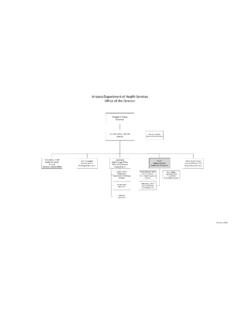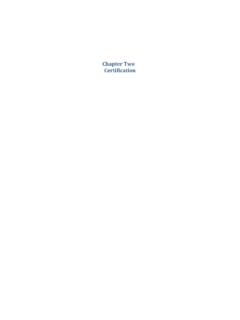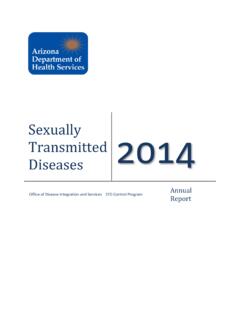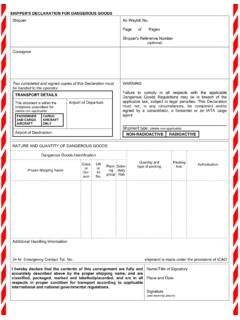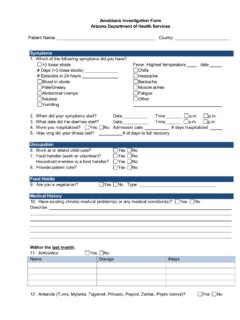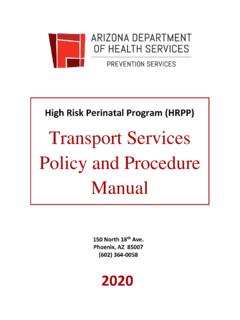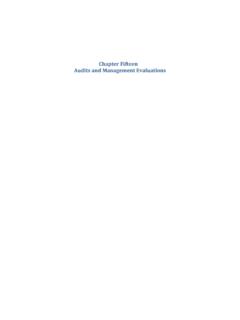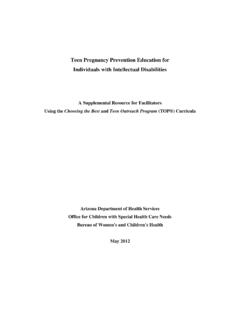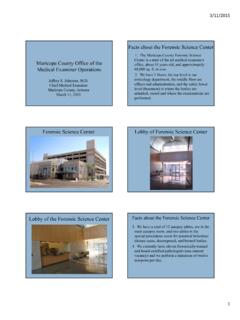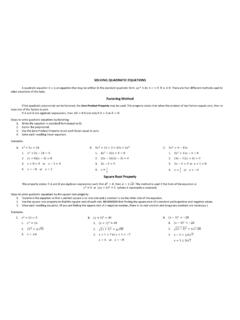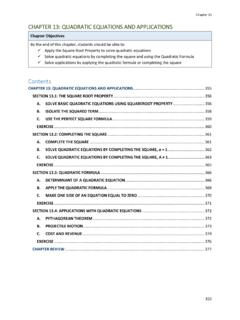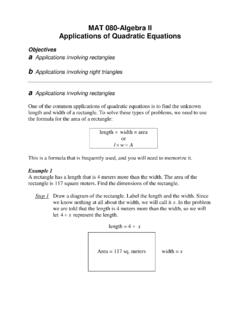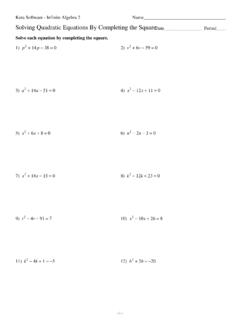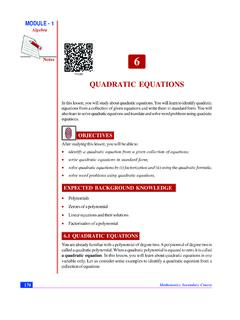Transcription of Quadratic Least Square Regression
1 Quadratic Least Square Regression also referred to as Non-Linear or Second Order Regression Quadratic Least Square Regression A nonlinear model is any model of the basic form in which the functional part of the model is not linear with respect to the unknown parameters, and the method of Least squares is used to estimate the values of the unknown Ref: NIST Non-Linear Curve Historically, many analytical methods have relied on linear models of the calibration relationship, where the instrument response is directly proportional to the amount of a target compound. With the advent of new detection techniques, and the fact that many techniques cannot be optimized for all the analytes, the analyst is increasingly likely to encounter situations where the linear model neither applies nor is appropriate.
2 Ref: SW846 8000C, Revision 3, March 2003, Section Non-Linear Curve Historically, many analytical methods have relied on linear models of the calibration relationship, where the instrument response is directly proportional to the amount of a target compound. With the advent of new detection techniques, and the fact that many techniques cannot be optimized for all the analytes, the analyst is increasingly likely to encounter situations where the linear model neither applies nor is appropriate. Ref: SW846 8000C, Revision 3, March 2003, Section Non-Linear Calibration Criteria In situations where the analyst knows that the instrument response does not follow a linear model over a sufficiently wide working range, or when the other approaches described here have not met the acceptance criteria, a non- linear calibration model may be employed.
3 Ref: SW846 8000C, Section NOTE: It is not EPA's intent to allow non- linear calibration to be used to compensate for detector saturation or to avoid proper instrument maintenance. Thus, non-linear calibration should not be employed for methods or instruments previously shown to exhibit linear calibration for the analytes of interest. Ref: SW846 8000C, Section When using a calibration model for quantitation, the curve must be continuous, continuously differentiable and monotonic over the calibration range. Ref: SW846 8000C, Section Non-Linear Calibration Criteria For non-linear calibration curves, based on a Least squares Regression (LSR) model construction coefficients (which describe correlation as equal to when representing the best curve fit) must be >.
4 Example of coefficients that describe correlation for a non-linear curve is the coefficient of determination (COD), r2. Ref: SW846 8000C, Section Quadratic Regression Equation y = ax2 + bx + c Where: y = Response Ax for External Standard or Ax/Ais for Internal Standard x = Concentration Cx for External Standard or Cx/Cis for Internal Standard Quadratic Regression Statistical Equations Coefficients (a,b,c). a = {[S(x2y) * S(xx)] [S(xy) * S(xx2)]}. { [(S(xx) * S(x2x2)] - [S(xx2)]2 }. b = {[S(xy) * S(x2x2)] [S(x2y) * S(xx2)]}. {[S(xx) * S(x2x2)] - [S(xx2)]2 }. c = [(Syi)/n] {b * [(Sxi)/n)]} {a * [S(xi2)/n]}. Quadratic Regression Statistical Equations Where: S(xx) = (Sxi2) - [(Sxi)2/n].
5 S(xy) = (Sxiyi) - [(Sxi)*(Syi)/n]. S(xx2) = (Sxi3) - [(Sxi)*(Sxi2)/n]. S(x2y) = (Sxi2yi) - [(Sxi2)*(Syi)/n]. S(x2x2) = (Sxi4) - [(Sxi2)2/n]. Statistical Equations: Coefficient of Determination (r2). r2 = [S(yi-yAVE)2 ] -{[(n-1) / (n-p)] * [S(yi-Yi)2]}. S(yi-yAVE)2. Quadratic Regression Statistical Equations Where: yi = individual values for each dependent variable xi = individual values for each independent variable yAVE = average of the y values n = number of pairs of data p = number of parameters in the polynomial equation ( , 3 for third order, 2 for second order). Yi = {[(2a*(Cx/Cis)2]-b2+b+(4ac)}/(4a). S = the sum of all the individual values Quadratic Regression Equations for Concentration External Standard Cx = (-b { (b2-[4a(c-Ax)])}) / (2a).)
6 Or Internal Standard Cx = (-b { (b2-[4a(c-Ax/Ais)])}) / (2a * Cis). Advantage The biggest advantage of nonlinear Least squares Regression over many other techniques is the broad range of functions that can be fit. Ref: Section Disadvantages Disadvantages include a strong sensitivity to outliers. The presence of one or two outliers in the data can seriously affect the results of a nonlinear analysis. In addition there are unfortunately fewer model validation tools for the detection of outliers in nonlinear Regression than there are for linear Regression Ref: NIST Sectio
